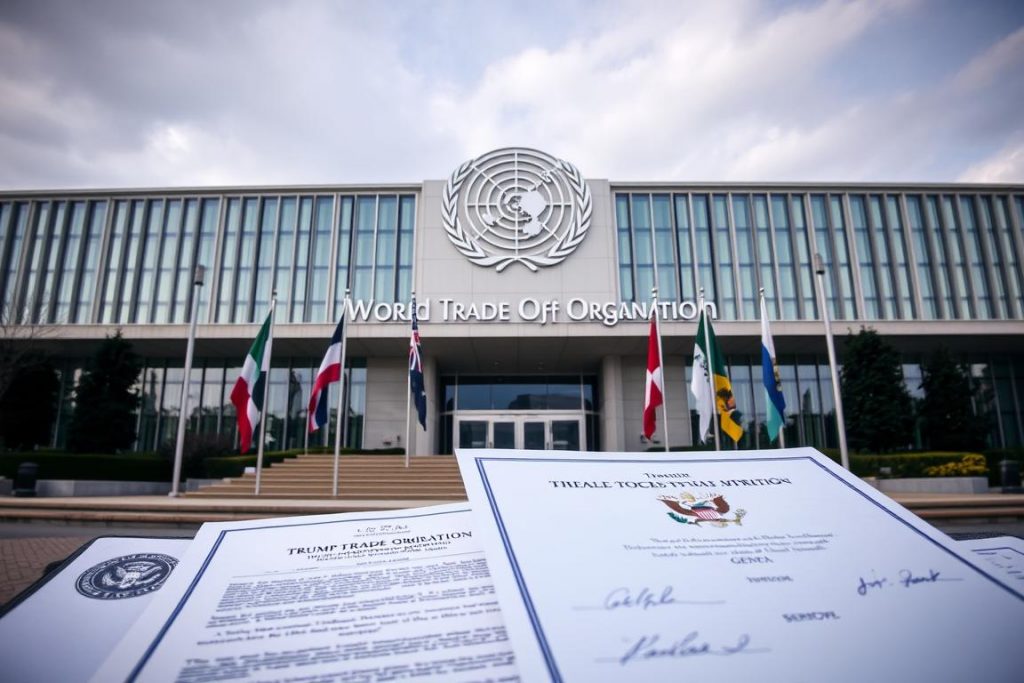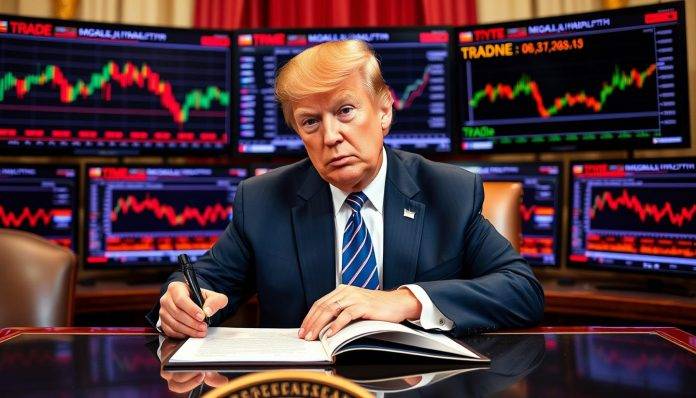As businesses and nations brace for potential disruptions, a critical question emerges: Does Trump’s approach make global trade safer through protectionism or riskier through unpredictability?
This analysis cuts through the political noise to examine the concrete impacts of Trump’s trade policies on global commerce.
Trump’s Trade Policies: Then and Now
Trump’s trade policies have significant implications for global markets and supply chains
During his first term, Trump implemented sweeping tariffs that fundamentally altered the international trade landscape. Steel and aluminium imports faced 25% and 10% tariffs, respectively, while Chinese goods worth over $380 billion were hit with various duties. The Biden administration maintained most measures against China while easing restrictions on allies like the EU, UK, and Japan.
Key Takeaways
For his second term, Trump has outlined an even more aggressive approach, including:
- Universal tariffs of 10% on imports from all countries
- Retaliatory tariffs up to 60% on Chinese imports
- Reciprocal tariffs based on tariff rate differences between the US and trading partners
- Sector-specific tariffs, particularly targeting automotive industries
- Country-specific measures, including 25% tariffs on all imports from Canada and Mexico
Unlike the first term, when Trump’s tariffs were often used as negotiation leverage, his second-term approach appears more focused on implementing these measures as permanent policy fixtures, which represents a significant shift from the multilateral, rules-based trading system that has dominated global commerce for decades.
Tariffs and Trade Wars: Economic Impact Analysis
The US-China trade relationship has been fundamentally altered by tariff policies
Trump’s tariff policies have already demonstrated measurable economic impacts during his first term. According to a study by the London School of Economics, the proposed second-term tariffs could reduce US GDP by 0.64%, China’s by 0.68%, and create ripple effects across global markets, with the UK facing a potential 0.14% GDP reduction and Germany 0.23%.
The US-China trade relationship, worth over $690 billion annually, faces particular strain. Chinese EV manufacturers are already relocating production to Europe, with BYD starting operations in Hungary and Huawei planning a factory near Paris, which represents a direct response to tariff pressures.
USMCA and Regional Trade Impacts
The United States-Mexico-Canada Agreement (USMCA), negotiated during Trump’s first term, replaced NAFTA but now faces new challenges. Trump’s threat of 25% tariffs on all Canadian and Mexican imports would violate USMCA terms and erode trust among signatories. For Mexico, approximately 50% of exports now face potential 25% tariffs, up from the previous 3%.
“Trump’s second term, far from being a passing disruption, is likely to act as a structural inflection point. For global economies, the response must be proactive: diversifying alliances, localizing value chains, and asserting greater strategic autonomy in a world where the rules are rapidly being rewritten.”
This structural shift is already visible in Canada, where Prime Minister Mark Carney’s immediate visits to Paris and London upon taking office signalled a deliberate pivot toward trade diversification beyond the US market.
Risk vs. Safety: The Trade Policy Paradox
Potential Safety Factors
- Reduced dependency on foreign supply chains
- Potential reshoring of manufacturing jobs
- Greater leverage in bilateral trade negotiations
- Protection for specific vulnerable industries
- Potential reduction in trade deficits
Potential Risk Factors
- Higher consumer prices due to tariffs
- Retaliatory measures from trading partners
- Supply chain disruptions and uncertainty
- Reduced global economic growth
- Weakening of multilateral trade institutions
Supply Chain Vulnerabilities
Trump’s tariff policies are forcing global companies to reconsider their supply chain strategies
The escalating tensions with China will likely result in major disruptions for businesses relying on Chinese imports or manufacturing. Key sectors facing particular vulnerability include:
Automotive
With the US importing $203.6 billion in passenger vehicles annually, tariffs could significantly impact demand. German and Mexican manufacturers are particularly exposed, with many major brands having substantial operations in Mexico that would be affected by Trump’s threatened tariffs.
Pharmaceuticals
As the second-most imported goods category ($203.2 billion annually), pharmaceutical products face potential disruption. While immediate impacts may be minimal due to inelastic demand, long-term investment and production could shift to the US under favorable regulations.
Electronics/Semiconductors
With electrical equipment imports valued at $257.9 billion in 2023, this sector faces significant exposure. Trump’s threatened tariffs on major chip manufacturing countries could particularly impact Taiwan, where TSMC produces 90% of the world’s most advanced chips.
The protectionist argument suggests these disruptions will ultimately strengthen domestic production and reduce vulnerabilities. However, economic analysis indicates the transition costs could be substantial and potentially outweigh long-term benefits.
Legal Framework and International Response

Trump’s tariff policies face potential challenges under WTO rules
Trump’s ability to implement sweeping tariffs stems from several US laws that grant the president significant authority without congressional approval:
- Trade Expansion Act of 1962 (Section 232): Allows tariffs on products threatening national security
- Trade Act of 1974 (Section 301): Authorizes tariffs against countries violating trade agreements
- Tariff Act of 1930 (Section 338): Permits tariffs in response to discrimination against US products
- International Emergency Economic Powers Act (1977): Grants broad import regulation powers under declared emergencies
While these provide substantial domestic authority, Trump’s tariff agenda potentially conflicts with World Trade Organization (WTO) rules. During his first term, various WTO members challenged US tariffs, with panels generally ruling against the US position. However, with the WTO Appellate Body effectively non-functional due to US blockage of judge appointments, enforcement mechanisms remain limited.
International Response Patterns
Trading partners have three primary response options to Trump’s tariff agenda:
- Challenge measures through the WTO dispute settlement system (limited effectiveness)
- Implement retaliatory tariffs (as seen during Trump’s first term)
- Negotiate bilateral agreements to secure exemptions or concessions
The EU, UK, and other major trading partners are already preparing contingency plans. European Central Bank president Christine Lagarde has advised that the approach should be “not to retaliate, but to negotiate,” potentially offering increased purchases of US oil, gas, or military equipment as bargaining chips.
Sector-Specific Impact Analysis
Different sectors face varying levels of exposure to Trump’s trade policies
| Sector | Import Value | Primary Risk Factors | Adaptation Strategies |
| Automotive | $203.6 billion | Price increases, demand reduction, supply chain disruption | Increased US production, supplier diversification, cost-sharing with consumers |
| Pharmaceuticals | $203.2 billion | Long-term investment shifts, regulatory changes | US facility expansion, strategic stockpiling, regulatory adaptation |
| Steel & Aluminium | $29.6 billion | Chinese market flooding, price volatility | Domestic capacity expansion, alternative supplier development |
| Electronics/Semiconductors | $257.9 billion | Supply chain complexity, production delays | Regional manufacturing hubs, inventory buffering |
| Fishery Products | $22.7 billion | Export volume decline (up to 22% for the UK) | Market diversification, value-added processing |
Each sector requires tailored strategies to navigate the changing trade landscape. Companies are increasingly adopting regional approaches to manufacturing and supply chain management, creating redundancies to mitigate disruption risks.
Regional Perspectives on Trump’s Trade Agenda
Different regions are developing distinct strategies to navigate Trump’s trade policies
North America
Canada and Mexico face particular challenges as USMCA partners, now threatened with 25% tariffs. Canada is pursuing aggressive trade diversification, with Prime Minister Carney prioritising European relationships. Mexico is taking a cautious negotiation approach while preparing for potential USMCA renegotiations.
Europe
The EU and UK are developing contingency plans while seeking negotiated solutions. European officials are exploring potential concessions on energy purchases and defence spending to secure tariff exemptions. Meanwhile, they’re accelerating trade agreements with other partners to reduce US dependency.
Asia
China faces the most direct impact but is responding by deepening regional integration through ASEAN and expanding Belt and Road Initiative investments. Japan and South Korea are caught between security alliances with the US and economic interests with China, requiring careful diplomatic balancing.
Gulf States’ Strategic Pivot
Gulf economies like the UAE and Saudi Arabia face multifaceted challenges from Trump’s trade policies. Short-term impacts include distorted supply chains and elevated input costs, while currency pressures affect import-dependent economies. However, these disruptions are accelerating strategic shifts, with Gulf sovereign wealth funds recalibrating portfolios toward Asia and the Global South, particularly in energy transition, agritech, and infrastructure.

Gulf states are accelerating economic diversification in response to global trade uncertainty
This pivot represents a broader pattern of regional blocs strengthening internal trade relationships as a hedge against US policy volatility. The BRICS+ expansion (now including Egypt, Ethiopia, Iran, and the UAE) and deepening ASEAN integration reflect similar strategic adaptations.
Future Outlook: 2025 and Beyond
Multiple scenarios are possible as global trade adapts to Trump’s policies
Looking ahead to 2025 and beyond, several key trends will likely shape the global trade landscape:
Regionalisation of Supply Chains
Companies are increasingly adopting “China+1” or regional manufacturing strategies to reduce tariff exposure. This trend accelerates the shift from globalisation toward regionalisation, with North American, European, and Asian supply chain clusters developing greater self-sufficiency.
Bilateral Deal-Making
Trump’s transactional approach to trade will likely result in a series of bilateral agreements rather than multilateral frameworks. Countries offering concrete benefits to US interests (energy purchases, defence spending, immigration cooperation) may secure preferential treatment.
WTO Reform or Decline
The multilateral trading system faces an existential challenge. Without US engagement, the WTO may continue to decline in relevance, or alternatively, other major economies could drive reform efforts that eventually bring the US back to the table.
“Trump’s economic policies are not just a negotiating tactic but a fundamental restructuring of how the US engages with global markets. Companies and countries that adapt quickly will find opportunities amid the disruption.”
Economic forecasts suggest initial GDP contractions across affected economies, with studies indicating potential global GDP losses of 0.56% by 2025, potentially reaching 1.08% by 2028 if retaliatory measures escalate. However, these models struggle to capture the long-term structural changes to global trade patterns that may emerge.
Business Adaptation Strategies

Companies are developing comprehensive strategies to navigate trade policy uncertainty
For businesses navigating this uncertain landscape, several strategic approaches are emerging as best practices:
Supply Chain Restructuring
Companies are conducting comprehensive tariff exposure assessments and developing regional manufacturing strategies. This includes identifying critical components with high tariff risk and developing alternative sourcing options or considering reshoring where economically viable.
Strategic Partnerships
Building relationships with suppliers and customers across multiple regions creates resilience against policy shifts. Companies are also exploring joint ventures that can navigate complex regulatory environments and provide local manufacturing presence in key markets.
Policy Engagement
Proactive engagement with trade policy development through industry associations and direct government relations can help shape outcomes. Companies are also developing scenario planning capabilities to quickly adapt to policy changes as they emerge.
The most successful companies will be those that view trade policy not simply as a risk to be managed but as a strategic variable that can create competitive advantage when navigated effectively.
Conclusion: Riskier Trade Environment Requires Strategic Adaptation
Businesses face critical strategic choices in navigating the new trade landscape
After comprehensive analysis of Trump’s trade policies, their economic impacts, and global responses, the verdict is clear: global trade under Trump is fundamentally riskier than under previous administrations. This increased risk stems from policy unpredictability, potential for retaliatory measures, and the structural weakening of multilateral trade frameworks that have provided stability for decades.
However, risk does not necessarily mean catastrophe. The global economy has demonstrated remarkable adaptability to Trump’s first-term policies, and businesses have developed sophisticated strategies to navigate trade disruptions. The coming years will likely see an acceleration of trends already underway: supply chain regionalization, strategic reshoring of critical industries, and the development of more resilient business models.
For policymakers, businesses, and investors, the key to success will be neither blind resistance to change nor passive acceptance of disruption, but rather strategic adaptation that recognizes both the challenges and opportunities in this new trade landscape.
Navigate Global Trade Uncertainty With Confidence
Download our comprehensive guide “Adapting to Trump’s Trade Policies: A Strategic Playbook for Global Businesses” to get detailed sector analysis, policy forecasts, and actionable strategies for protecting your supply chain and identifying new opportunities.
To read more articles on Finance, please follow the link


